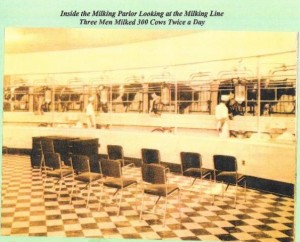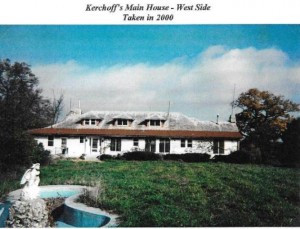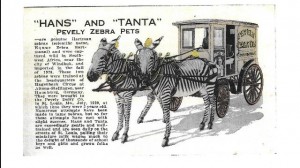Pevely Farms Homeowners Association
Pevely Farms - A Once Thriving Dairy Farm
Pevely Farms Operation Dominated
the Crescent area from the 1920s to the 1950s
Several golf courses and dozens of luxury homes have made Crescent a sought-after West County address, but in past years the area was a sleepy community dominated by the Pevely Dairy Operation.
The business started in 1887 in Pevely. Farmer Mark Kerckhoff, one of 23 children of a German immigrant family, started a butter route to St. Louis. Later he added milk to this product line and people began referring to it as Pevely milk. The business got a big boost when Daniel Kerckhoff, son of Mark Kerckhoff, won the dairy concession at the 1904 Worlds Fair in St. Louis. At first the business was located on South Seventh Street, but in 1917 they moved to the corner of Grand and Chouteau. The company became a subsidiary Prairie Farms in 1989.
“ I’ll make a wild guess and say the Pevely Operation employed about 200 men and at that time the population of Crescent was about 500,” said Raymond Pemberton. Now a Georgia resident, Pemberton has written a history of his family and the Crescent area, located just north of I-44 at the Lewis Road exit. Pemberton’s father and many other people in Crescent worked for Pevely, which maintained a farm, dairy and greenhouse operation in the peaceful country hamlet in the 1920s, ‘30s and ‘40s.
“The dairy had 300 milking cows, and the milk was pasteurized, bottled and shipped to St. Louis where delivery men would take it to the neighborhoods,” Pemberton added. Carloads of St. Louisans came to watch the state-of-art dairy operations through big windows in the showroom.
“My father worked in the greenhouses, where they grew roses, gardenias and orchids for the florists in St. Louis,” said Clarence Weber, who has lived in Crescent all of this 77 years. “The dairy closed before 1950 and the greenhouses continued through the 1950’s,” he added.
“The buildings are mostly gone now, but this was a huge operation” in its heyday, said Riley Pemberton, a Gray Summit resident who grew up in Crescent.
“Pevely had it’s own water pumps, one for the house and another one that pumped water out of the river for the animals,” Riley Pemberton added. The old wooden water storage tower is still standing near the main house. The dairy operation also had it’s own coal-fired boiler that provided steam heat to the houses and barns. In addition to a number of barns and outbuildings there was also a boarding house that typically had 10 to 12 hired hands living there. These men worked on the dairy and farming operations.
The deteriorating mansion on the farm, still owned by the Kerckhoff family of St. Louis, is strictly off limits to just about everyone these days. It was once a grand structure, with a lodge-style dining room, rathskeller for parties, an intercom system, elaborate woodwork, windows and fixtures – and all the details were taken care of by Mabel an d Coleman Nash, who served as the live-in cook, maid and butler. They lived upstairs. In an era when most local families got by with an outhouse and an outside pump for water, this mansion had grand bathrooms with hot and cold running water.
d Coleman Nash, who served as the live-in cook, maid and butler. They lived upstairs. In an era when most local families got by with an outhouse and an outside pump for water, this mansion had grand bathrooms with hot and cold running water.
The model farm, dairy and home were kept immaculately groomed and it was considered to be a showplace. Even the mile-log driveway, lined with beautiful cement gateposts and perfectly symmetrical trees, was swept every week. The Kerckhoff family invited friends to the farm for weekend outings and parties.
In his memoirs, Pemberton tells about living in the company town during the Depression. “My dad’s pay was $21 a month and the worked six days a week,” said Pemberton, who noted that his uncles all worked for the dairy too. “Mr. Kerckhoff also enjoyed his horses,” said Pemberton, who noted that Kerckhoff had about a dozen race-horses and a kennel full of his prized hunting dogs.
“On e summer (1929) the dairy had gotten several zebras to pull the milk wagons in St. Louis,” said Raymond Pemberton. “These were kept in the pasture next to my house and they were very tame. We would get on top of the fence post and try to coax one over and then we would jump on its back for a ride. Of course we soon fell off, but how many kids get to ride a zebra?” he added.
e summer (1929) the dairy had gotten several zebras to pull the milk wagons in St. Louis,” said Raymond Pemberton. “These were kept in the pasture next to my house and they were very tame. We would get on top of the fence post and try to coax one over and then we would jump on its back for a ride. Of course we soon fell off, but how many kids get to ride a zebra?” he added.
“Once a year, at Christmas, we were invited up to the big house,” said Raymond Pemberton. “That’s the only time we were allowed near the place. There was a high fence, watchdogs and big iron gates. They had a party for all of the Crescent kids in the basement of the house where there was a big party room,” he added. “We kids would put on a play and they would give us snacks and treats.”
A vintage structure in Crescent is the old Pevely Dairy caretaker house, a large three-story home on Lewis Road. The house has been renovated, yet it looks very much like it did during the Pevely Dairy says.
Riley Pemberton and his family grew up in the Pevely Dairy’s caretaker house because his dad, James Riley Pemberton, worked for Pevely Dairy. “Dad and his fours brothers all worked at the dairy,” said Pemberton, who noted that his father worked for three generations of the Kerckhoff family. “If it weren’t for the Kerckhoffs we would never have made it,” said Pemberton’s sister Reba Pemberton Border, now a Eureka resident. For a time, the dairy workers received one gallon of milk per day in addition to their pay. “We were all so poor and the Pevely Dairy provided jobs for all the families in Crescent,” she said.
Note: The above information is from the Eureka Missouri Sesquicentennial Book published by Bell Books in 2007 and written by Jo Beck. For a copy of the book contact the Eureka Historical Society, PO Box 4, Eureka MO 63025.
Note: In recent years the Kerckhoff family sold the property for real estate development and the mansion was torn down.